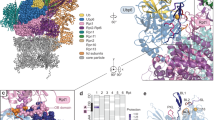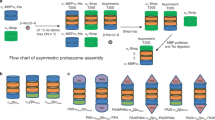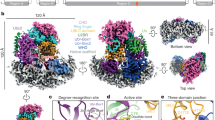Abstract
The 26S proteasome degrades polyubiquitylated (polyUb) proteins by an ATP-dependent mechanism. Here we show that binding of model polyUb substrates to the 19S regulator of mammalian and yeast 26S proteasomes enhances the peptidase activities of the 20S proteasome about two-fold in a process requiring ATP hydrolysis. Monoubiquitylated proteins or tetraubiquitin alone exert no effect. However, 26S proteasomes from the yeast α3ΔN open-gate mutant and the rpt2YA and rpt5YA mutants with impaired gating can still be activated (approximately 1.3-fold to 1.8-fold) by polyUb-protein binding. Thus, binding of polyUb substrates to the 19S regulator stabilizes gate opening of the 20S proteasome and induces conformational changes of the 20S proteasome that facilitate channeling of substrates and their access to active sites. In consequence, polyUb substrates will allosterically stimulate their own degradation.
This is a preview of subscription content, access via your institution
Access options
Subscribe to this journal
Receive 12 print issues and online access
$189.00 per year
only $15.75 per issue
Buy this article
- Purchase on Springer Link
- Instant access to full article PDF
Prices may be subject to local taxes which are calculated during checkout






Similar content being viewed by others
References
Voges, D., Zwickl, P. & Baumeister, W. The 26S proteasome: a molecular machine designed for controlled proteolysis. Annu. Rev. Biochem. 68, 1015–1068 (1999).
Groll, M. et al. A gated channel into the proteasome core particle. Nat. Struct. Biol. 7, 1062–1067 (2000).
Rechsteiner, M. & Hill, C.P. Mobilizing the proteolytic machine: cell biological roles of proteasome activators and inhibitors. Trends Cell Biol. 15, 27–33 (2005).
Liu, C.W. et al. ATP binding and ATP hydrolysis play distinct roles in the function of 26S proteasome. Mol. Cell 24, 39–50 (2006).
Verma, R. et al. Role of Rpn11 metalloprotease in deubiquitination and degradation by the 26S proteasome. Science 298, 611–615 (2002).
Yao, T. & Cohen, R.E. A cryptic protease couples deubiquitination and degradation by the proteasome. Nature 419, 403–407 (2002).
Rubin, D.M., Glickman, M.H., Larsen, C.N., Dhruvakumar, S. & Finley, D. Active site mutants in the six regulatory particle ATPases reveal multiple roles for ATP in the proteasome. EMBO J. 17, 4909–4919 (1998).
Braun, B.C. et al. The base of the proteasome regulatory particle exhibits chaperone-like activity. Nat. Cell Biol. 1, 221–226 (1999).
Kohler, A. et al. The axial channel of the proteasome core particle is gated by the Rpt2 ATPase and controls both substrate entry and product release. Mol. Cell 7, 1143–1152 (2001).
Smith, D.M. et al. Docking of the proteasomal ATPases' carboxyl termini in the 20S proteasome's α ring opens the gate for substrate entry. Mol. Cell 27, 731–744 (2007).
Lam, Y.A., Lawson, T.G., Velayutham, M., Zweier, J.L. & Pickart, C.M. A proteasomal ATPase subunit recognizes the polyubiquitin degradation signal. Nature 416, 763–767 (2002).
Pickart, C.M. & Cohen, R.E. Proteasomes and their kin: proteases in the machine age. Nat. Rev. Mol. Cell Biol. 5, 177–187 (2004).
Seeger, M., Ferrell, K., Frank, R. & Dubiel, W. HIV-1 tat inhibits the 20 S proteasome and its 11 S regulator-mediated activation. J. Biol. Chem. 272, 8145–8148 (1997).
Ferrell, K., Wilkinson, C.R., Dubiel, W. & Gordon, C. Regulatory subunit interactions of the 26S proteasome, a complex problem. Trends Biochem. Sci. 25, 83–88 (2000).
Babbitt, S.E. et al. ATP hydrolysis-dependent disassembly of the 26S proteasome is part of the catalytic cycle. Cell 121, 553–565 (2005).
Kleijnen, M.F. et al. Stability of the proteasome can be regulated allosterically through engagement of its proteolytic active sites. Nat. Struct. Mol. Biol. 14, 1180–1188 (2007).
Hetfeld, B.K. et al. The zinc finger of the CSN-associated deubiquitinating enzyme USP15 is essential to rescue the E3 ligase Rbx1. Curr. Biol. 15, 1217–1221 (2005).
Thrower, J.S., Hoffman, L., Rechsteiner, M. & Pickart, C.M. Recognition of the polyubiquitin proteolytic signal. EMBO J. 19, 94–102 (2000).
Fenteany, G. et al. Inhibition of proteasome activities and subunit-specific amino-terminal threonine modification by lactacystin. Science 268, 726–731 (1995).
Schmidtke, G., Emch, S., Groettrup, M. & Holzhutter, H.G. Evidence for the existence of a non-catalytic modifier site of peptide hydrolysis by the 20 S proteasome. J. Biol. Chem. 275, 22056–22063 (2000).
Kisselev, A.F., Kaganovich, D. & Goldberg, A.L. Binding of hydrophobic peptides to several non-catalytic sites promotes peptide hydrolysis by all active sites of 20 S proteasomes. Evidence for peptide-induced channel opening in the α-rings. J. Biol. Chem. 277, 22260–22270 (2002).
Glickman, M.H. Getting in and out of the proteasome. Semin. Cell Dev. Biol. 11, 149–158 (2000).
Kohler, A. et al. The substrate translocation channel of the proteasome. Biochimie 83, 325–332 (2001).
Verma, R., Oania, R., Graumann, J. & Deshaies, R.J. Multiubiquitin chain receptors define a layer of substrate selectivity in the ubiquitin-proteasome system. Cell 118, 99–110 (2004).
Benaroudj, N., Zwickl, P., Seemuller, E., Baumeister, W. & Goldberg, A.L. ATP hydrolysis by the proteasome regulatory complex PAN serves multiple functions in protein degradation. Mol. Cell 11, 69–78 (2003).
Navon, A. & Goldberg, A.L. Proteins are unfolded on the surface of the ATPase ring before transport into the proteasome. Mol. Cell 8, 1339–1349 (2001).
Amerik, A.Y. & Hochstrasser, M. Mechanism and function of deubiquitinating enzymes. Biochim. Biophys. Acta 1695, 189–207 (2004).
Stohwasser, R., Salzmann, U., Giesebrecht, J., Kloetzel, P.M. & Holzhutter, H.G. Kinetic evidences for facilitation of peptide channelling by the proteasome activator PA28. Eur. J. Biochem. 267, 6221–6230 (2000).
Kopp, F., Dahlmann, B. & Kuehn, L. Reconstitution of hybrid proteasomes from purified PA700–20 S complexes and PA28αβ activator: ultrastructure and peptidase activities. J. Mol. Biol. 313, 465–471 (2001).
Walz, J. et al. 26S proteasome structure revealed by three-dimensional electron microscopy. J. Struct. Biol. 121, 19–29 (1998).
da Fonseca, P.C. & Morris, E.P. Structure of the human 26S proteasome: Subunit radial displacements open the gate into the proteolytic core. J. Biol. Chem. 283, 23305–23314 (2008).
Groettrup, M. et al. The interferon-γ-inducible 11 S regulator (PA28) and the LMP2/LMP7 subunits govern the peptide production by the 20 S proteasome in vitro. J. Biol. Chem. 270, 23808–23815 (1995).
Dahlmann, B., Kuehn, L. & Reinauer, H. Studies on the activation by ATP of the 26 S proteasome complex from rat skeletal muscle. Biochem. J. 309, 195–202 (1995).
Wendler, P., Lehmann, A., Janek, K., Baumgart, S. & Enenkel, C. The bipartite nuclear localization sequence of Rpn2 is required for nuclear import of proteasomal base complexes via karyopherin αβ and proteasome functions. J. Biol. Chem. 279, 37751–37762 (2004).
Acknowledgements
We would like to thank D. Finley (Harvard Medical School) for the yeast strains rpt2YA and rpt5YA, J. Dohmen (University of Cologne) for the rpn10 mutant strain and A. Lehmann for excellent technical assistance. This work was supported by grants from the Deutsche Forschungsgemeinschaft (SFB421 and SFB 740 to P.-M.K.).
Author information
Authors and Affiliations
Contributions
D.B.-O. and A.H. performed all biochemical experiments; C.E. purified yeast proteasomes; G.C. generated the MUC1 peptides; M.S. and H.-G.H. supervised the biochemical and enzyme kinetic experiments; B.D. purified the mammalian proteasomes; D.B.-O., B.D. and P.-M.K. prepared the manuscript; P.-M.K. designed the project.
Corresponding author
Supplementary information
Supplementary Text and Figures
Supplementary Figures 1–4 and Supplementary Methods (PDF 297 kb)
Rights and permissions
About this article
Cite this article
Bech-Otschir, D., Helfrich, A., Enenkel, C. et al. Polyubiquitin substrates allosterically activate their own degradation by the 26S proteasome. Nat Struct Mol Biol 16, 219–225 (2009). https://doi.org/10.1038/nsmb.1547
Received:
Accepted:
Published:
Issue Date:
DOI: https://doi.org/10.1038/nsmb.1547
This article is cited by
-
Allosteric regulation of the 20S proteasome by the Catalytic Core Regulators (CCRs) family
Nature Communications (2023)
-
Ubiquitin receptors are required for substrate-mediated activation of the proteasome’s unfolding ability
Scientific Reports (2019)
-
High-resolution cryo-EM structure of the proteasome in complex with ADP-AlFx
Cell Research (2017)
-
Ramping up degradation for proliferation
Nature Cell Biology (2016)
-
Regulated protein turnover: snapshots of the proteasome in action
Nature Reviews Molecular Cell Biology (2014)



